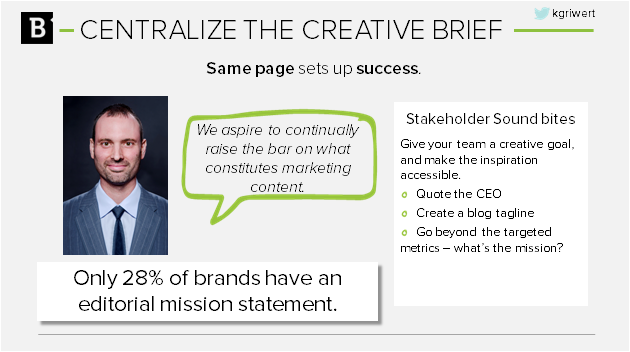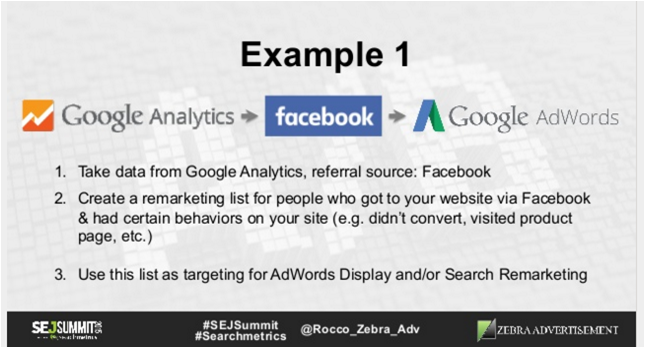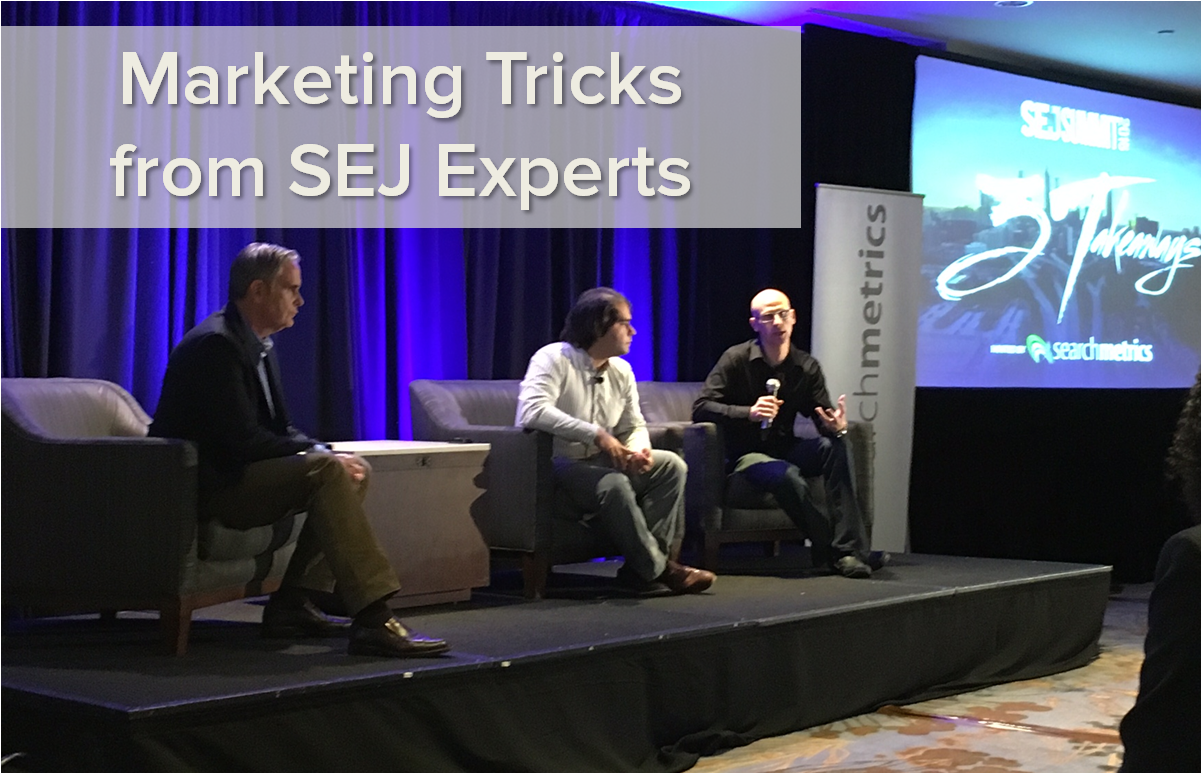Discussing “marketing tricks” can feel cheap – like you’re “pulling one over” on your audience or your boss. But this year’s SEJ Summit Atlanta presentations each offered attendees “three tricks and takeaways” for smarter marketing. After spending a few days with fellow marketing directors at the event, one thing is clear:
We all aspire to be more effective at our jobs – and finding valuable ways to save time on day-to-day tasks creates more time for the big picture tasks.
The invite-only nature of the event made it extremely educational and collaborative. Lots of candid ideas were shared, tough questions were asked and no vendors were pitched as the solution. The downside of an invite-only event is that many marketers miss out on really great ideas. You can see all of the presentation slides online here, and I’m offering up five of the top “tricks” I took home, from my fellow presenters AND the conversations with attendees.
1. NoMo Fomo: Create demand by demonstrating demand.
Be unavailable … or at least pretend to be unavailable. This one is from a UX presentation by Erin Everart of The Home Depot, who knows a thing or two about selling products online. She’s delightfully witty, and you can follow her on Twitter here.
One of Erin’s user experiences recommendations was to include the remaining stock number for each item. Creating a fear of missing out inspires discerning buyers to pull the trigger.

Some similar principles attendees discussed:
- Display a counter for how long a sale or promotion will last.
- Create a product category for “leaving soon” or “limited time” offers (Netflix does this brilliantly, as one blogger chronicles)
- Use last-chance language in emails for for webinars, events, etc.
Works well for:
- All ecommerce brands
- Any brand/ industry offering an event or sale
2. Open-ended questions: Seek (or buy) answers to identify user intent.
Both Grant Simmons of Homes.com and Jordan Koene of Searchmetrics spoke about understanding user intent before spending a dollar (or minute) on your content. As Grant put it, when you identify what motivates people, you can get your brand into their consideration set and inspire them to search for your products. For example, his ability to understand what inspires people to relocate enables him to position his content to inspire them to research Homes.com offerings.

Grant’s tools of the trade to open-ended questions:
- In person or phone surveys
- Opt-in online surveys
- Opt-in email surveys
- Survey tools, such as:
- Survey Monkey
- Fluid Survey
- Google Consumer Surveys
Jordan’s approach to finding answers to open-ended surveys:
Jordan advises a strategy rooted in competitive insights. By exploring the answers that currently rank well in results pages for queries about your offering, you can reverse engineer ideas about the information people seek. Use a paid tool or manually search, looking for things like:
- Format (text or videos?)
- General word count (in-depth or quick answers?)
- Informational gaps (what do you know that the currently ranking sites obviously do not?)

Works well for:
- Every business with a website.
Grant offered a particularly memorable quote on the irony of Google’s new Rank Brain, that should remind marketers – particularly those obsessed with search performance – about their audience and goals:
“SEO was always about thinking like search engines. Now search engines want to think like us. So really, we should think like us.”
More on this in a post from Brafton CEO Richard Pattinson:
3. Reddit: Watch the rising networks and gain early adopter advantage.
Disclaimer: This one may not be “super simple,” but the basic premise of experimenting with new networks is one obvious strategy that’s too often overlooked.
Why aren’t marketers on Reddit? Because brands are terrified of the controversial and sometimes unsavory commentary that can run rampant among the network’s loyal users. As a reddit voyeur (read: a user who doesn’t comment), I often observe extremely high engagement, but many companies don’t have a presence on the platform.
Or do they?
Brent Csutoras of Pixelroad shared indisputable numbers on the rising value of Reddit, and why he thinks it’s on the path to becoming a mainstream marketing platform. It exceed 200 million unique views in October of 2015, the company has launched a vaguely defined “Growth Team” and the site is supposedly reviewing “Promotional Rules.” Plus, he shared case studies of many well-known brands already using the channel, like the Marriot and Transamerica.

Reddit tips and tricks:
- Find the right users. There are countless subreddits. Go niche or go home.
- Be light-hearted. Campaigns that are too sales-y won’t be a fit for most Redditors, who use the site to discover news and often delete cookies. Fun and entertaining campaigns can go a long way. Case in point: Marriott saw 193,000 clicks to a contest page promoted on reddit when post itself didn’t even have a link
- Design for Reddit. Brent showed that companies simply using the Self Post format and borrowing the reddit colors or alien in the visual aspects of their campaign had high success rates.

- Prepare for 1:1 engagement. While this network may have early adopter advantage, it doesn’t have a low barrier of entry. People use reddit for 1:1 conversation and the campaign team needs to find time to reply when possible. And on that note …
- Embrace tough Qs. Engaging in dialogue is what drives the Reddit user base.
- STAY engaged. Reddit threads don’t die, and it’s important to follow and contribute to the conversation around your campaign. You won’t be able to “control” it, but you can keep it in check with effective monitoring.
Works well for:
- B2Cs
- Brands that can create light-hearted campaigns
Works less well for:
- Brands with politically charged offerings
- Possibly B2Bs… this was largely debated at the event! (What do you think?)
Brent covered the roses and thorns of Reddit, but here are some other networks to watch that I discussed with fellow attendees:
- TheListApp (for an organic presence)
- Spotify (for advertising)
- Taboolah (for distribution)
4. One goal for many roles: Create an editorial mission statement.
This tip comes from yours truly. It was part of my presentation, and in a candid conversation with Charlie Needham of Autoshopsolutions.com, he told me this was one of his most valued take–homes. (Thank you Charlie – great insight as I may have overlooked this nugget in a crib sheet of my own presentation…)
Marketers are becoming much more savvy about defining the marketing goals of their content programs. Not a post passes from our Marketing Writer to this very WordPress site without discussion of thought leadership KPIs we’ll measure, or traffic goals we aim to exceed. But can any content contributor on your team (simply) state an editorial mission?

Just 28 percent of companies have an editorial mission for their corporate content, but the CMI reports those brands that have defined a mission statement are consistently among the top performers.
So what is an editorial mission statement?
For one HR recruiting firm that works with Brafton, the mission of their blog is to act as “job seekers’ best friends and recruiters’ personal assistants.”
You can see how a statement like that can define the content topics, style, tone and presentation of web content. (Ie: Conversational, relatable and humorous blogs or videos for candidates. Checklists, recaps and useful graphics or templates for hiring managers.)
To define and achieve your editorial mission:
- Align with the company mission: How can you contribute to the business’s overall objective via content? Bonus – get a CEO soundbite so that everyone at your company feels their stake in the content.
- Keep it concise: An editorial mission statement should be memorable.
- Make it elastic: A mission statement that leaves a little room for interpretation among your creative teams will inspire wordplay or visuals that elevate the impact.
- Distribute it, widely: Make sure everyone who touches your web content can access the mission statement so that you can achieve consistency across networks.
Works well for:
- Any business.
- **Especially useful for businesses with large or multi-department teams that need to connect content, but still essential for a one-woman team to stay focused.
And here’s my full presentation:
5. Retargeting: Use cross-platform conversion metrics to set the audience parameters.
Rocco Baldassarre of Zebra Advertising came to SEJ Summit after making the news for a Facebook campaign he managed, so you best believe we sat in attention when he offered this retargeting tip.
Use conversion metrics from one platform:
- Gather conversion (or near conversion) data on one platform (ie: Google Analytics data for your website)
- Use that as the basis of a remarketing list in a related ad network (ie: Google Adwords)
- Create tailored content that maps to the behavior or platform preferences of that list

Works for:
- Any business that’s using retargeting (and data shows that last year 71 percent of marketers spent anywhere from 10 percent to 50 percent of their online budgets on retargeting).




